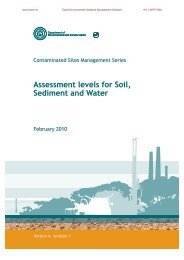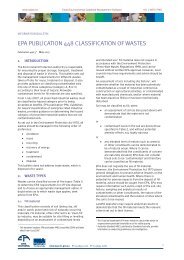Soil Generic Assessment Criteria for Human Health Risk ... - ESdat
Soil Generic Assessment Criteria for Human Health Risk ... - ESdat
Soil Generic Assessment Criteria for Human Health Risk ... - ESdat
Create successful ePaper yourself
Turn your PDF publications into a flip-book with our unique Google optimized e-Paper software.
www.esdat.net Esdat Environmental Database Management Software +61 2 8875 7948<br />
Despite the lack of data the decision was taken to use route-to-route extrapolation unless there<br />
was evidence to suggest that this was not appropriate. The alternative would have been to not<br />
derive GAC <strong>for</strong> these compounds. This option was considered less useful than having a set of<br />
GAC <strong>for</strong> compounds where there remained some uncertainty in the inhalation HCV used to derive<br />
them.<br />
There were two cases where route-to-route extrapolation was considered inappropriate:<br />
1‐methylnaphthalene and 2-methylnaphthalene, both of which have an HCV oral<br />
but no HCV inhal<br />
.<br />
There was evidence to suggest that the toxicity of these compounds via inhalation was likely to<br />
be significantly greater than their toxicity via ingestion and there<strong>for</strong>e use of the HCV oral<br />
may have<br />
resulted in GAC that were unprotective.<br />
• Where alternative health criteria were available from different authoritative sources then priority<br />
was given to the most recent expert reviews, provided these had considered all available data.<br />
Preference was also given to longer term studies. Where there was no clear case <strong>for</strong> selection of a<br />
particular HCV, priority was given to the most conservative.<br />
• Three contaminants were considered as non-threshold substances; 1-methylnaphthalene,<br />
bromodichloromethane and carbazole. There were insufficient data to derive an ID <strong>for</strong> carbazole.<br />
Dose-response data with reported 95 th percentile lower confidence limit benchmark dose<br />
levels (BMDL10) derived from animal experiments involving oral exposure were available <strong>for</strong><br />
1‐methylnaphthalene and bromodichloromethane and these were used to derive the ID oral<br />
<strong>for</strong> each<br />
contaminant in accordance with the methodology given in the Environment Agency of England and<br />
Wales SR2 report.<br />
Methodology<br />
• Reference concentrations (RfC) have been converted to inhalation HCV in accordance with the<br />
Environment Agency of England and Wales SR2 guidance, i.e. by multiplying by 20 m 3 of air inhaled<br />
per day and dividing by 70 kg standard body mass.<br />
3.3<br />
Selection of Mean Daily Intakes<br />
The procedures <strong>for</strong> collation and choice of mean daily intake (MDI) were in general accordance with the principles<br />
set out in the Environment Agency of England and Wales SR2 document. As with the HCV, all 33 sources listed<br />
in Appendix A of the SR2 report were consulted and relevant data <strong>for</strong> each contaminant were summarised on the<br />
contaminant pro<strong>for</strong>mas. Again, sources that held no data relevant to the substance have been removed from the<br />
pro<strong>for</strong>ma to reduce the overall length of Appendix B. Assumptions used in the selection of recommended MDI are<br />
summarised below:<br />
• MDI have been based on available relevant data. Data from near point sources were not considered<br />
relevant and have not been used <strong>for</strong> the derivation of MDI.<br />
• Preference has been given to data on likely average exposure to the UK population. If no UK<br />
data were available preference was given to average exposure from other countries. Where only<br />
maximum values were reported, but did not relate to point sources, then these were used as a<br />
conservative estimate of MDI.<br />
• Where suitable data were available from more than one in<strong>for</strong>mation source and there was no<br />
obvious preference <strong>for</strong> one of these sources then the most conservative (highest) value was chosen<br />
as the basis of the MDI.<br />
• If no data were available and the literature suggests the exposure is likely to be negligible, the MDI<br />
has been set to zero, in line with SR2.<br />
15








